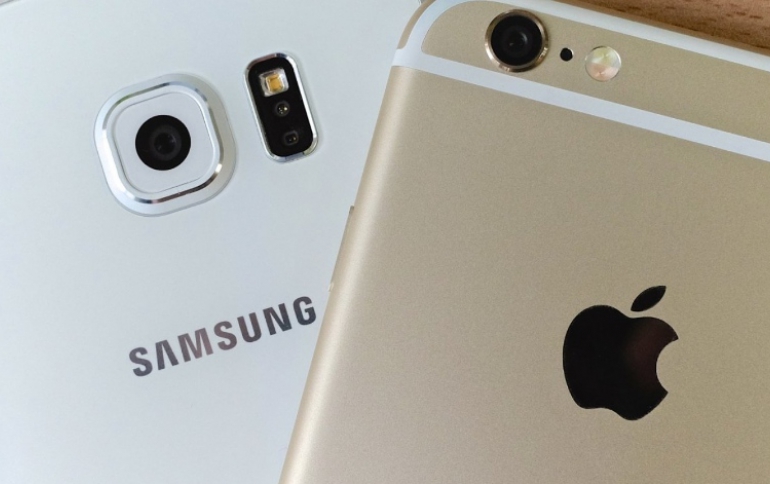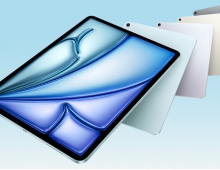
Apple Closes the Gap on Samsung Fourth Quarter's Worldwide Smartphone Shipments
Having spent 11 quarters prior to 4Q14 as the number two smartphone vendor in terms of shipments, Apple managed to close the gap to a near tie with Samsung in 4Q14, according to preliminary data released by the International Data Corporation (IDC). Led by the success of theiPhone 6/6+ models, Apple reduced the volume gap to just 600,000 units in the fourth quarter. Despite being far more profitable for quite some time, Apple's shipment volumes trailed Samsung's by more than 33 million units during the same quarter a year ago. Continued success from Apple, coupled with the ongoing challenges facing Samsung, could enable Apple to overtake Samsung during the 2015 calendar year, IDC says. Samsung's challenges have not only come from Apple, but also from the increasing number of low-cost Android OEMs that are putting out products at much lower margins. In order for Samsung to regain its share at the top, it will either have to accept lower margins from here forward or revamp its high-end strategy to compete with Apple.
An elevated consumer appetite for big-screen devices, as well as Apple's push into China and other countries, saw iPhone sales up 44% in the U.S. and up 97% in the BRIC countries (Brazil, Russia, India, China). Sales doubled year-over-year in China, Brazil, and Singapore. What remains to be seen is how long Apple can sustain this runaway growth.
Samsung remained the leader in the worldwide smartphone market for the quarter and for the year, but nonetheless experienced continued competitive realities. With increased pressure in the high-end from Apple, and at the low-end to midrange from Chinese manufacturers Xiaomi, Huawei, ZTE, and others, Samsung faces a multi-front battle. To this end, Samsung has streamlined its operations and product portfolio to become more competitive in the market.
Buried within its latest financial results Samsung has all but confirmed that from now on its premium handsets, such as the upcoming Galaxy S6 will be honed from quality metals and glass, rather than the plastics it usually turns to. It has also said that it will be building fewer phones to make differentiation clearer.
More interesting handset releases are expected to occur during the Mobile World Congress, which officially gets underway in Barcelona on March 2.
Top Five Smartphone Vendors, Shipments, Market Share and Year-Over-Year Growth, Q4 2014 Preliminary Data (Units in Millions)
Vendor |
4Q14 Shipment Volumes
|
4Q14 Market Share
|
4Q13 Shipment Volumes
|
4Q13 Market Share
|
Year-Over-Year Change
|
1. Samsung |
75.1 |
20.01% |
84.4 |
28.83% |
-11.0% |
2. Apple |
74.5 |
19.85% |
51.0 |
17.43% |
46.0% |
3. *Lenovo |
24.7 |
6.59% |
13.9 |
4.75% |
77.9% |
4. Huawei |
23.5 |
6.25% |
16.6 |
5.66% |
41.7% |
5. Xiaomi |
16.6 |
4.42% |
5.9 |
2.03% |
178.6% |
Others |
160.9 |
42.9% |
120.9 |
41.31% |
33.1% |
Total |
375.2 |
100.0% |
292.7 |
100.0% |
28.2% |
*Lenovo + Motorola |
24.7 |
6.6% |
19.5 |
6.7% |
26.4% |
Source: IDC Worldwide Quarterly Mobile Phone Tracker, January 29, 2015
Lenovo was a distant third in the fourth quarter, narrowly edging out Huawei thanks to the completion of the Motorola acquisition earlier in the quarter. Lenovo continued to dominate the sub-$150 handset market in China with a portfolio of devices including the Golden Warriors S8 and more expensive flagship Vibe Z2 pro. Lenovo has recently announced that it will bring the Motorola brand back to China in 2015, starting with the Moto X next month.
Huawei returned to the list of top 5 worldwide vendors, emphasizing its midrange and high-end smartphones (P Series and Mate Series respectively), and saw continued success with its Honor line. Huawei attributed its 2014 success to improved brand awareness and overall customer experience, which it will look to evolve even further in 2015.
Xiaomi fell from the third position to fifth in 4Q14, beating out LG for the final spot among the top 5. Even though volumes declined slightly from 3Q14 levels, Xiaomi posted the largest year-over-year growth of all the leading vendors, thanks to a solid demand within its home country of China and a steady release of new devices, including the Mi4 LTE. Xiaomi's grip on the number 5 spot is tenuous at best, with LG and ZTE following close behind.
Smartphone vendors shipped a total of 375.2 million units during the fourth quarter of 2014 (4Q14), resulting in 28.2% growth when compared to the 292.7 million units shipped in 4Q13 and 11.9% sequential growth above the 335.3 million units shipped in 3Q14. For the full year, the worldwide smartphone market saw a total of 1,301.1 million units shipped, up 27.6% from the 1,019.4 million units shipped in 2013.
Another research firm announced that the Android smartphone shipment numbers were down for the first time in history.
According to ABI Research's latest data, shipments of Android smartphones hit 206 million, down from 217 million in the previous quarter of 2014.
At the same time that Android was slipping, the iPhone was climbing -- 90%. Its 74.5 million handsets shipped over the fourth quarter of 2014 dwarfs the 39.3 million it managed in the third quarter.




















